Heat Stress Effect on the Grain Yield of Three Drought-Tolerant Maize Varieties under Varying Growth Conditions
Abstract
:1. Introduction
2. Results
2.1. Effects of Heat Stress on the Maize Biological and Economic Yield Attributes
2.2. Varietal Performance on the Biological and Economic Yield Attributes of Maize
2.3. Effects of Soil Amendment on the Maize Biological and Economic Yield Attributes
2.4. Effects of Soil Type on the Maize Biological and Economic Yield Attributes
2.5. Interaction of Heat Stress, Maize Variety, Soil Amendment, and Soil Type on the Maize Biological and Economic Yield Attributes
3. Discussion
3.1. Effects of Heat Stress on Maize Biological and Economic Yield Attributes
3.2. Varietal Performance on the Biological and Economic Yield Attributes of Maize
3.3. Effects of Soil Amendment on Maize Biological and Economic Yield Attributes
3.4. Effects of Soil Type on Maize Biological and Economic Yield Attributes
3.5. Interaction of Heat Stress, Maize Variety, Soil Amendment, and Soil Type on Maize Biological and Economic Yield Attributes
4. Materials and Methods
4.1. Description of the Study Site
4.2. Treatments, Experimental Design, and Cultural Practices
4.3. Measurement of Plant Response Attributes
4.4. Data Analysis
5. Conclusions
Author Contributions
Funding
Institutional Review Board Statement
Informed Consent Statement
Data Availability Statement
Acknowledgments
Conflicts of Interest
Appendix A
| Molelwane Soil (Hutton Form) | Tlapeng Soil (Arcadia Form) | |
|---|---|---|
| Particle size distribution | ||
| Sand % | 82 | 64 |
| Silt % | 4 | 8 |
| Clay % | 14 | 28 |
| Textural class | Loamy sandy | Sandy clay loam |
| Chemical properties | ||
| pH (KCl) 1:2.5 | 4.98 | 5.83 |
| P (Bray1) (mg kg−1) | 11 | 2 |
| K (mg kg−1) | 290 | 138 |
| Ca (mg kg−1) | 390 | 2000 |
| Mg (mg kg−1) | 163 | 1310 |
| Na (mg kg−1) | 5 | 215 |
| Total N (mg kg−1) | 376 | 616 |
| %C | 0.37 | 0.76 |
| S-value | 4 | 22 |
| Ca % | 48 | 45.2 |
| Mg % | 33.2 | 49 |
| K % | 18.3 | 1.6 |
| Na % | 0.5 | 4.2 |
| Ext. acidity (cmol kg−1) | 0.04 | 0.036 |
References
- OECD/FAO. Cereals. In Agricultural Outlook 2020–2029; OECD/FAO: Rome, Italy, 2020; p. 17. [Google Scholar]
- Smale, M.; Byerlee, D.; Jayne, T. Maize revolutions in sub-Saharan Africa. In An African Green Revolution; Otsuka, K., Larson, D., Eds.; The World Bank; Springer: Dordrecht, The Netherlands, 2011; p. 34. [Google Scholar]
- Santpoort, R. The Drivers of Maize Area Expansion in Sub-Saharan Africa. How Policies to Boost Maize Production Overlook the Interests of Smallholder Farmers. Land 2020, 9, 68. [Google Scholar] [CrossRef] [Green Version]
- NEPAD. Agriculture in Africa: Transformation and Outlook; New Partnership for African Development: Johannesburg, South Africa, 2013. [Google Scholar]
- Van Ittersum, M.K.; van Bussel, L.G.J.; Wolf, J.; Grassini, P.; van Wart, J.; Guilpart, N.; Claessens, L.; de Groot, H.; Wiebe, K.; Mason-D’Croz, D.; et al. Can sub-Saharan Africa feed itself? Proc. Natl. Acad. Sci. USA 2016, 113, 14964–14969. [Google Scholar] [CrossRef] [PubMed] [Green Version]
- Ramirez-Cabral, N.Y.Z.; Kumar, L.; Shabani, F. Global alterations in areas of suitability for maize production from climate change and using a mechanistic species distribution model (CLIMEX). Sci. Rep. 2017, 7, 5910. [Google Scholar] [CrossRef] [PubMed]
- FAO. The State of Food Security and Nutrition in the World 2018: Building Climate Resilience for Food Security and Nutrition; Food & Agriculture Organization: Rome, Italy, 2018. [Google Scholar]
- Landman, W.A.; Engelbrecht, F.; Hewitson, B.; Malherbe, J.; Van der Merwe, J. Towards bridging the gap between climate change projections and maize producers in South Africa. Theor. Appl. Climatol. 2018, 132, 1153–1163. [Google Scholar] [CrossRef] [Green Version]
- Pachauri, R.K.; Allen, M.R.; Barros, V.R.; Broome, J.; Cramer, W.; Christ, R.; Church, J.A.; Clarke, L.; Dahe, Q.; Dasgupta, P. Climate Change 2014: Synthesis Report. Contribution of Working Groups I, II and III to the Fifth Assessment Report of the Intergovernmental Panel on Climate Change; IPCC: Geneva, Switzerland, 2014; p. 151. [Google Scholar]
- Wu, W.; Ma, B.L.; Whalen, J.K. Enhancing rapeseed tolerance to heat and drought stresses in a changing climate: Perspectives for stress adaptation from root system architecture. In Advances in Agronomy; Academic Press: Cambridge, MA, USA, 2018; p. 157. [Google Scholar]
- Cairns, J.E.; Hellin, J.; Sonder, K.; Araus, J.L.; MacRobert, J.F.; Thierfelder, C.; Prasanna, B.M. Adapting maize production to climate change in sub-Saharan Africa. Food Secur. 2013, 5, 345–360. [Google Scholar] [CrossRef] [Green Version]
- Zhao, C.; Liu, B.; Piao, S.; Wang, X.; Lobell, D.B.; Huang, Y.; Huang, M.; Yao, Y.; Bassu, S.; Ciais, P. Temperature increase reduces global yields of major crops in four independent estimates. Proc. Natl. Acad. Sci. USA 2017, 114, 9326–9331. [Google Scholar] [CrossRef] [PubMed] [Green Version]
- Yang, H.; Gu, X.-T.; Ding, M.-Q.; Lu, W.-P.; Lu, D.-L. Weakened carbon and nitrogen metabolisms under post-silking heat stress reduce the yield and dry matter accumulation in waxy maize. J. Integr. Agric. 2020, 19, 78–88. [Google Scholar] [CrossRef]
- Tesfaye, K.; Zaidi, P.; Gbegbelegbe, S.; Boeber, C.; Getaneh, F.; Seetharam, K.; Erenstein, O.; Stirling, C. Climate change impacts and potential benefits of heat-tolerant maize in South Asia. Theor. Appl. Climatol. 2017, 130, 959–970. [Google Scholar] [CrossRef] [Green Version]
- Yan, P.; Tao, Z.; Chen, Y.; Zhang, X.; Sui, P. Spring maize kernel number and assimilate supply responses to high-temperature stress under field conditions. Agron. J. 2017, 109, 1433–1442. [Google Scholar] [CrossRef]
- Rezaei, E.E.; Webber, H.; Gaiser, T.; Naab, J.; Ewert, F. Heat stress in cereals: Mechanisms and modelling. Eur. J. Agron. 2015, 64, 98–113. [Google Scholar] [CrossRef]
- ACB. The Water Efficient Maize for Africa (WEMA) Project—Profiteering Not Philanthropy! Africa Centre for Biodiversity: Johannesburg, South Africa, 2017; p. 61. [Google Scholar]
- Inyang, P.; Ene, C.O.; Emmanuel, A.; Chukwudi, U.P.; Ikeogu, U.N. Environmental impact and genetic expressions of new drought-tolerant maize genotypes in derived savannah agro-ecology. Not. Sci. Biol. 2021, 13, 10691. [Google Scholar] [CrossRef]
- Karmakar, R.; Das, I.; Dutta, D.; Rakshit, A. Potential effects of climate change on soil properties: A review. Sci. Int. 2016, 4, 51–73. [Google Scholar] [CrossRef] [Green Version]
- Pareek, N. Climate change impact on soils: Adaptation and mitigation. MOJ Ecol. Environ. Sci. 2017, 2, 00026. [Google Scholar] [CrossRef] [Green Version]
- van Wilgen, N.J.; Goodall, V.; Holness, S.; Chown, S.L.; McGeoch, M.A. Rising temperatures and changing rainfall patterns in South Africa’s national parks. Int. J. Climatol. 2015, 36, 706–721. [Google Scholar] [CrossRef]
- Cairns, J.E.; Crossa, J.; Zaidi, P.; Grudloyma, P.; Sanchez, C.; Araus, J.L.; Thaitad, S.; Makumbi, D.; Magorokosho, C.; Bänziger, M. Identification of drought, heat, and combined drought and heat tolerant donors in maize. Crop. Sci. 2013, 53, 1335–1346. [Google Scholar] [CrossRef] [Green Version]
- Mayer, L.I.; Rattalino Edreira, J.I.; Maddonni, G.A. Oil yield components of maize crops exposed to heat stress during early and late grain-filling stages. Crop. Sci. 2014, 54, 2236–2250. [Google Scholar] [CrossRef]
- Waraich, E.; Ahmad, R.; Halim, A.; Aziz, T. Alleviation of temperature stress by nutrient management in crop plants: A review. J. Soil Sci. Plant Nutr. 2012, 12, 221–244. [Google Scholar] [CrossRef] [Green Version]
- Mangani, R.; Tesfamariam, E.H.; Engelbrecht, C.J.; Bellocchi, G.; Hassen, A.; Mangani, T. Potential impacts of extreme weather events in main maize (Zea mays L.) producing areas of South Africa under rainfed conditions. Reg. Environ. Chang. 2019, 19, 1441–1452. [Google Scholar] [CrossRef]
- Baiyeri, K.P.; Chukwudi, U.P.; Chizaram, C.A.; Aneke, N. Maximizing rice husk waste for Daucus carota production. Int. J. Recycl. Org. Waste Agric. 2019, 8, 399–406. [Google Scholar] [CrossRef] [Green Version]
- Elbasyoni, I.S. Performance and stability of commercial wheat cultivars under terminal heat stress. Agronomy 2018, 8, 37. [Google Scholar] [CrossRef] [Green Version]
- Tena, E.; Goshu, F.; Mohamad, H.; Tesfa, M.; Tesfaye, D.; Seife, A. Genotype× environment interaction by AMMI and GGE-biplot analysis for sugar yield in three crop cycles of sugarcane (Saccharum officinirum L.) clones in Ethiopia. Cogent Food Agric. 2019, 5, 1651925. [Google Scholar] [CrossRef]
- Oliveira, T.R.A.D.; Carvalho, H.W.L.D.; Oliveira, G.H.F.; Costa, E.F.N.; Gravina, G.D.A.; Santos, R.D.D.; Carvalho Filho, J.L.S.D. Hybrid maize selection through GGE biplot analysis. Bragantia 2019, 78, 166–174. [Google Scholar] [CrossRef]
- Chukwudi, U.P.; Agbo, C.U.; Ene, C.O.; Uba, C.U.; Enyi, J.I. Analysis of leaf yield components in fluted pumpkin (Telfairia occidentalis Hook F.) grown in derived Savannah agro-ecology. Not. Sci. Biol. 2017, 9, 386–391. [Google Scholar] [CrossRef]
- Yan, W.; Tinker, N.A. Biplot analysis of multi-environment trial data: Principles and applications. Can. J. Plant Sci. 2006, 86, 623–645. [Google Scholar] [CrossRef] [Green Version]
- Yan, W.; Kang, M.S.; Ma, B.; Woods, S.; Cornelius, P.L. GGE Biplot vs. AMMI Analysis of Genotype-by-Environment Data. Crop. Sci. 2007, 47, 643–653. [Google Scholar] [CrossRef]
- Tiwari, Y.K.; Yadav, S.K. High temperature stress tolerance in maize (Zea mays L.): Physiological and molecular mechanisms. J. Plant Biol. 2019, 62, 93–102. [Google Scholar] [CrossRef]
- Uba, C.U.; Agbo, C.U.; Chukwudi, U.P.; Efusie, A.A.; Muojiama, S.O. Field evaluation of yield and yield component traits of breeding lines of maize over two seasons in derived Savannah agro-ecology. Not. Sci. Biol. 2018, 10, 567–574. [Google Scholar] [CrossRef] [Green Version]
- Belay, M.; Adare, K. Response of growth, yield components, and yield of hybrid maize (Zea mays L.) varieties to newly introduced blended NPS and N fertilizer rates at Haramaya, Eastern Ethiopia. Cogent Food Agric. 2020, 6, 1771115. [Google Scholar] [CrossRef]
- Feng, G.; Wang, Y.; Yan, L.; Zhou, X.; Wang, S.; Gao, Q.; Mi, G.; Yu, H.; Cui, Z. Effects of nitrogen and three soil types on maize (Zea mays L.) grain yield in northeast China. Appl. Ecol. Environ. Res. 2019, 17, 4229–4243. [Google Scholar] [CrossRef]
- Adeyemo, A.J.; Akingbola, O.O.; Ojeniyi, S.O. Effects of poultry manure on soil infiltration, organic matter contents and maize performance on two contrasting degraded alfisols in southwestern Nigeria. Int. J. Recycl. Org. Waste Agric. 2019, 8, 73–80. [Google Scholar] [CrossRef] [Green Version]
- DAFF. South African Varieties List as Maintained by the Registrar of Plant Improvement; SA Stats: Johannesburg, South Africa, 2019; p. 39. [Google Scholar]
- Edreira, J.I.R.; Otegui, M.E. Heat stress in temperate and tropical maize hybrids: Differences in crop growth, biomass partitioning and reserves use. Field Crop. Res. 2012, 130, 87–98. [Google Scholar] [CrossRef]
- Liang, Q.; Chen, H.; Gong, Y.; Fan, M.; Yang, H.; Lal, R.; Kuzyakov, Y. Effects of 15 years of manure and inorganic fertilizers on soil organic carbon fractions in a wheat-maize system in the North China Plain. Nutr. Cycl. Agroecosyst. 2012, 92, 21–33. [Google Scholar] [CrossRef]
- Martínez, E.; Domingo, F.; Roselló, A.; Serra, J.; Boixadera, J.; Lloveras, J. The effects of dairy cattle manure and mineral N fertilizer on irrigated maize and soil N and organic C. Eur. J. Agron. 2017, 83, 78–85. [Google Scholar] [CrossRef]
- Geng, Y.; Cao, G.; Wang, L.; Wang, S. Effects of equal chemical fertilizer substitutions with organic manure on yield, dry matter, and nitrogen uptake of spring maize and soil nitrogen distribution. PLoS ONE 2019, 14, e0219512. [Google Scholar] [CrossRef] [Green Version]
- Zhang, Y.; Li, C.; Wang, Y.; Hu, Y.; Christie, P.; Zhang, J.; Li, X. Maize yield and soil fertility with combined use of compost and inorganic fertilizers on a calcareous soil on the North China Plain. Soil Tillage Res. 2016, 155, 85–94. [Google Scholar] [CrossRef]
- Yan, W. GGE Biplot vs. AMMI graphs for genotype-by-environment data analysis. J. Indian Soc. Agric. Stat. 2011, 65, 181–193. [Google Scholar]
- Mahmood, F.; Khan, I.; Ashraf, U.; Shahzad, T.; Hussain, S.; Shahid, M.; Abid, M.; Ullah, S. Effects of organic and inorganic manures on maize and their residual impact on soil physico-chemical properties. J. Soil Sci. Plant Nutr. 2017, 17, 22–32. [Google Scholar] [CrossRef] [Green Version]
- Schoebitz, M.; Vidal, G. Microbial consortium and pig slurry to improve chemical properties of degraded soil and nutrient plant uptake. J. Soil Sci. Plant Nutr. 2016, 16, 226–236. [Google Scholar] [CrossRef]
- Fang, J.; Su, Y. Effects of soils and irrigation volume on maize yield, irrigation water productivity, and nitrogen uptake. Sci. Rep. 2019, 9, 7740. [Google Scholar] [CrossRef] [PubMed]
- Moral, F.J.; Rebollo, F.J. Characterization of soil fertility using the Rasch model. J. Soil Sci. Plant Nutr. 2017, 17, 486–498. [Google Scholar] [CrossRef]
- Ahmadi, S.H.; Andersen, M.N.; Plauborg, F.; Poulsen, R.T.; Jensen, C.R.; Sepaskhah, A.R.; Hansen, S. Effects of irrigation strategies and soils on field grown potatoes: Yield and water productivity. Agric. Water Manag. 2010, 97, 1923–1930. [Google Scholar] [CrossRef]
- Rao, I.M.; Miles, J.W.; Beebe, S.E.; Horst, W.J. Root adaptations to soils with low fertility and aluminium toxicity. Ann. Bot. 2016, 118, 593–605. [Google Scholar] [CrossRef] [PubMed] [Green Version]
- Hutsch, B.W.; Schubert, S. Harvest index of maize (Zea mays L.): Are there possibilities for improvement? In Advances in Agronomy; Sparks, D.L., Ed.; Elsevier: Cambridge, MA, USA, 2017; Volume 146, pp. 37–82. [Google Scholar]
- Ali, N.; Anjum, M.M. Effect of different nitrogen rates on growth, yield and quality of maize. Middle East J. Agric. Res. 2017, 6, 107–112. [Google Scholar]
- Tollenaar, M.; Lee, E.A. Yield potential, yield stability and stress tolerance in maize. Field Crop. Res. 2002, 75, 161–169. [Google Scholar] [CrossRef]
- NWPG. North West Environment Outlook Report 2018; North West Provincial Government: Mafikeng, South Africa, 2018; pp. 1–52. [Google Scholar]
- Soil Classification Working Group. Soil Classification: A Taxonomic System for South Africa, 2nd ed.; Department of Agricultural Development: Pretoria, South Africa, 1991; p. 257. [Google Scholar]
- Jung, S.; Hütsch, B.W.; Schubert, S. Salt stress reduces kernel number of corn by inhibiting plasma membrane H+-ATPase activity. Plant Physiol. Biochem. 2017, 113, 198–207. [Google Scholar] [CrossRef] [PubMed]
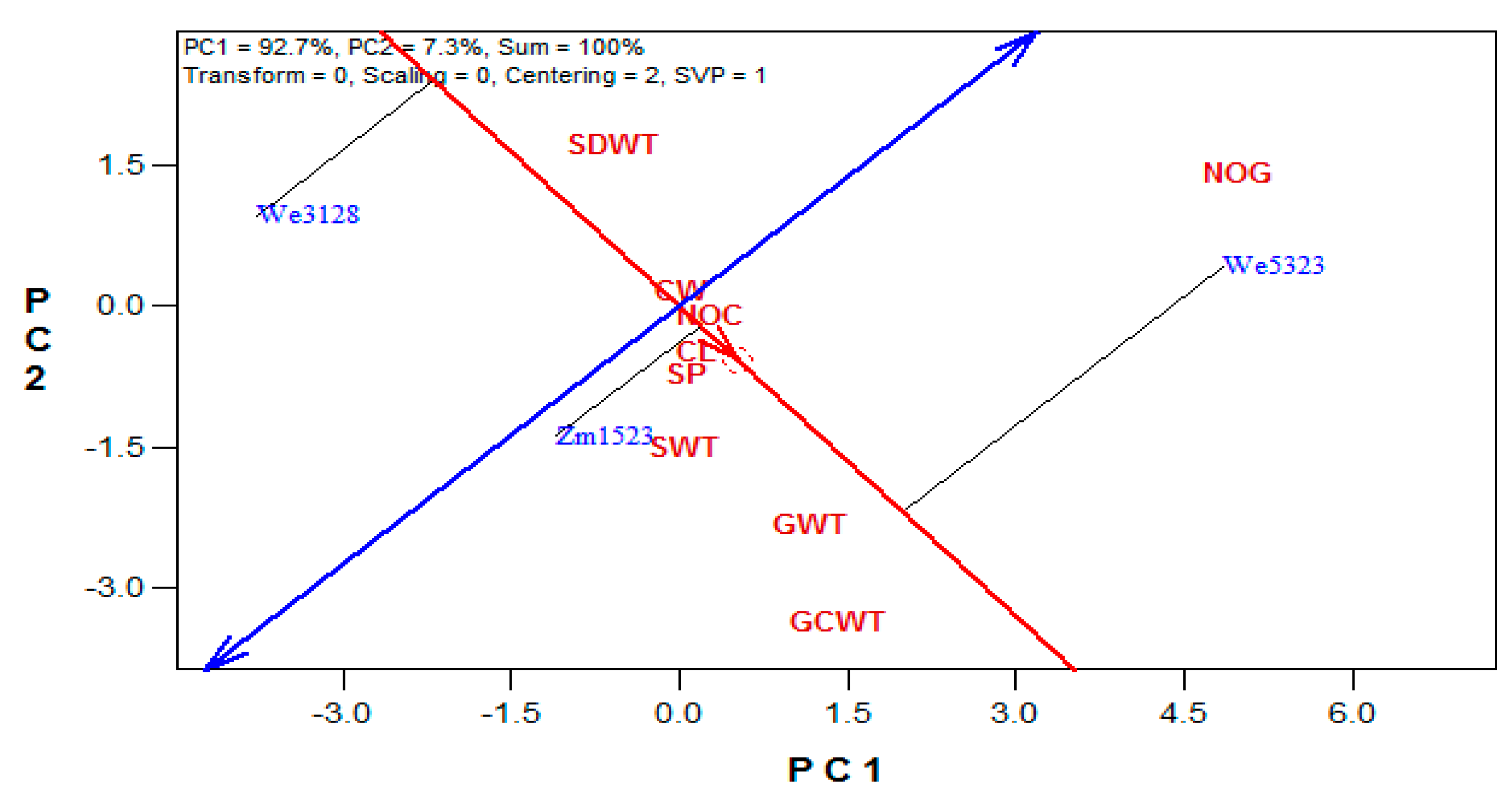
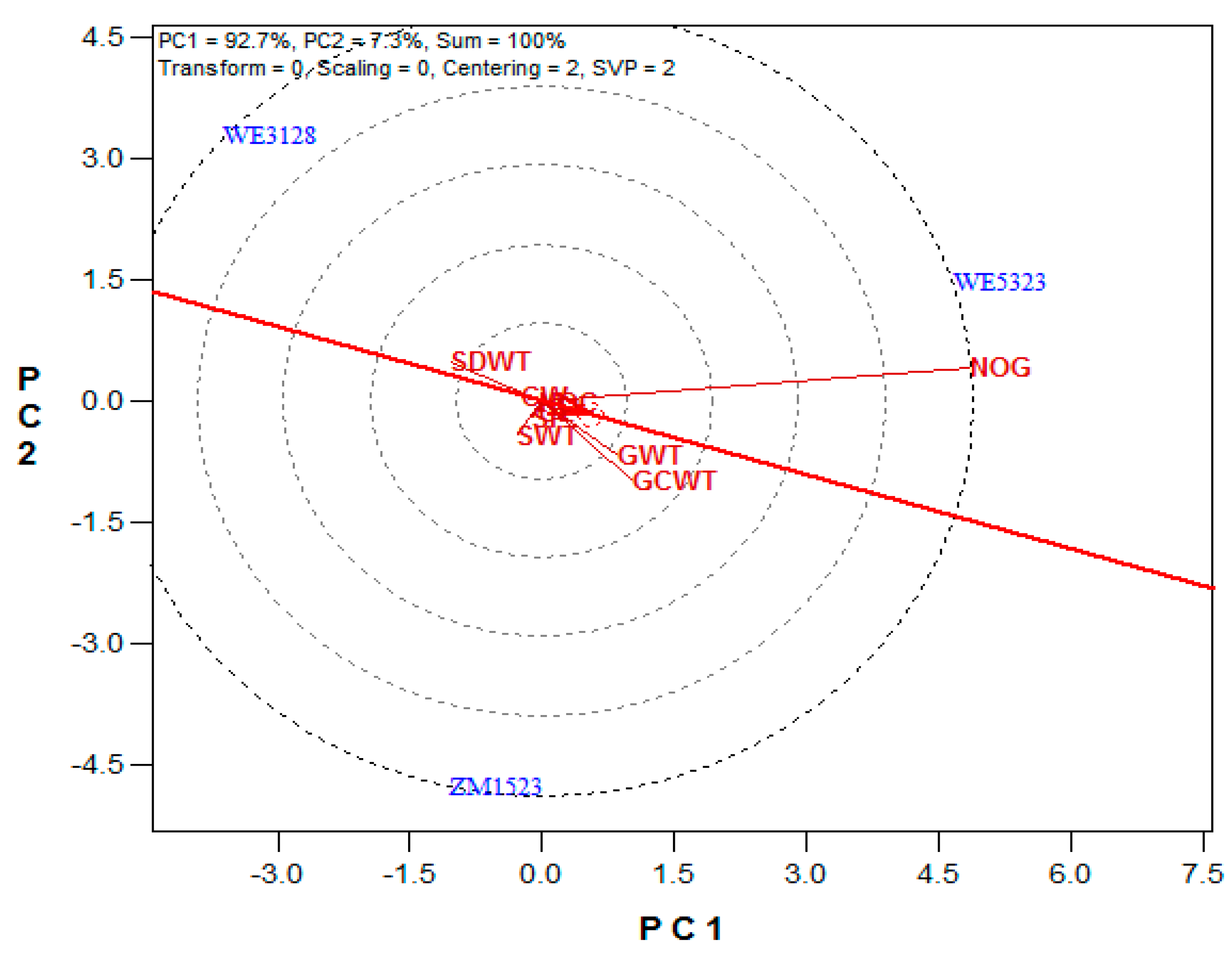
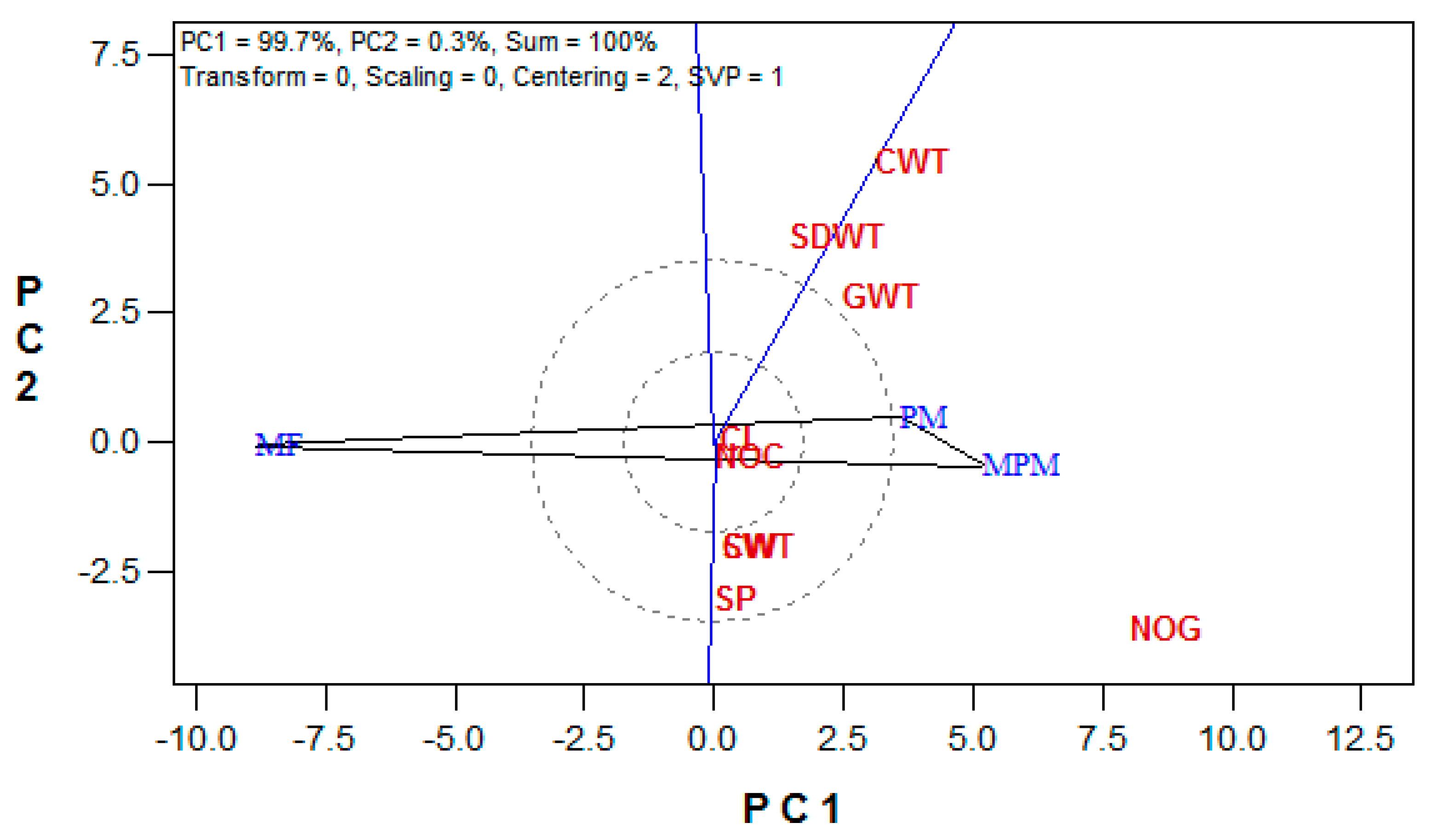

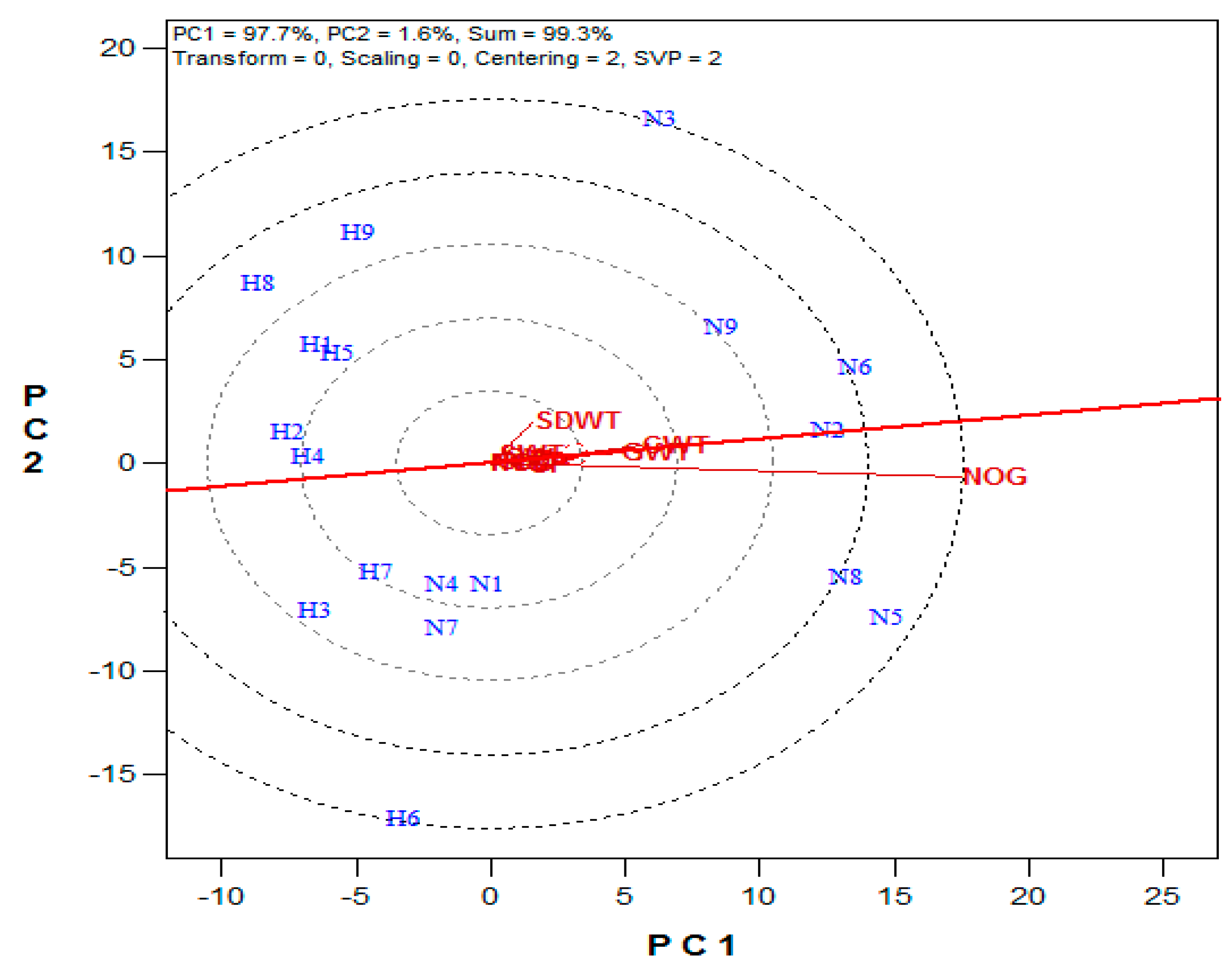
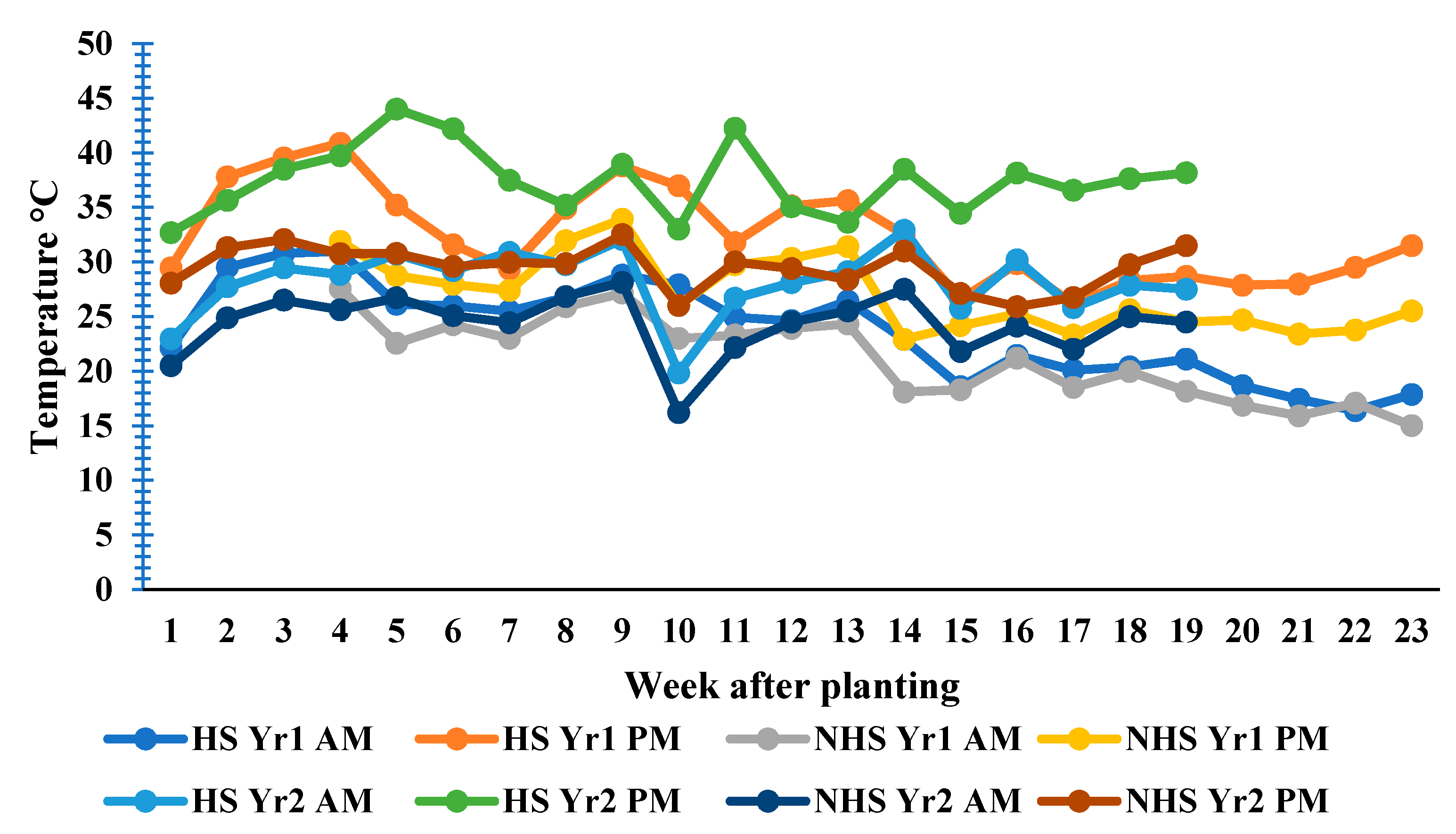
| NoC | CL | CW | CWt | GWt | SP | NoG | SWt | SDWt | |
|---|---|---|---|---|---|---|---|---|---|
| cm | mm | g Plant−1 | g Plant−1 | % | g Plant−1 | g Plant−1 | |||
| Heat stress | |||||||||
| NHS | 1.3 a | 13.5 a | 39.7 a | 112.3 a | 86.7 a | 75.5 a | 339.0 a | 25.6 a | 94.7 a |
| HS | 1.3 a | 10.3 b | 31.0 b | 40.8 b | 23.8 b | 48.8 b | 105.4 b | 22.1 b | 73.2 b |
| F-LSD (0.05) | 0.2 | 0.7 | 1.4 | 7.4 | 6.6 | 5.0 | 30.5 | 1.4 | 7.1 |
| Maize variety | |||||||||
| WE3128 | 1.3 b | 11.5 b | 36.3 a | 69.5 b | 49.9 b | 61.9 a | 205.9 b | 23.5 b | 89.4 a |
| WE5323 | 1.2 b | 11.6 b | 34.3 b | 79.9 a | 58.3 a | 61.2 a | 245.4 a | 21.8 c | 79.8 b |
| ZM1523 | 1.5 a | 12.6 a | 35.4 ab | 80.1 a | 57.6 ab | 63.3 a | 215.1 ab | 26.2 a | 82.7 ab |
| F-LSD (0.05) | 0.2 | 0.9 | 1.8 | 9.0 | 8.1 | 6.1 | 37.4 | 1.7 | 8.7 |
| Soil amendment | |||||||||
| MF | 1.2 b | 10.9 b | 34.0 b | 48.8 b | 32.9 b | 62.5 a | 151.2 b | 22.8 b | 71.2 b |
| MPM | 1.5 a | 12.5 a | 37.0 a | 90.4 a | 67.2 a | 63.3 a | 265.7 a | 25.4 a | 89.7 a |
| PM | 1.3 b | 12.4 a | 34.9 b | 90.3 a | 65.7 a | 60.6 a | 249.5 a | 23.4 b | 91.0 a |
| F-LSD (0.05) | 0.2 | 0.9 | 1.8 | 9.0 | 8.1 | 6.1 | 37.4 | 1.7 | 8.7 |
| Soil type | |||||||||
| Loamy Sand | 1.3 a | 11.6 b | 34.3 b | 73.4 a | 52.8 a | 59.6 b | 206.8 b | 24.1 a | 79.5 b |
| Sandy Clay Loam | 1.3 a | 12.3 a | 36.4 a | 79.7 a | 57.8 a | 64.6 a | 237.5 a | 23.6 a | 88.4 a |
| F-LSD (0.05) | 0.2 | 0.7 | 1.4 | 7.4 | 6.6 | 5.0 | 30.5 | 1.4 | 7.1 |
| Treatment Interactions | NoC | CL | CW | CWt | GWt | NoG | SP | SWt | SDWt |
|---|---|---|---|---|---|---|---|---|---|
| HS.MV | ** | ** | ** | ** | ** | ** | ** | ** | * |
| HS.SA | ** | ** | ** | ** | ** | ** | ** | ** | ** |
| MV.SA | ** | ** | ** | * | * | * | n.s. | ** | * |
| HS.ST | n.s. | ** | ** | ** | * | * | ** | * | ** |
| MV.ST | * | ** | ** | ** | * | ** | * | * | * |
| SA.ST | ** | ** | ** | ** | ** | ** | ** | ** | ** |
| HS.MV.SA | ** | ** | ** | ** | ** | ** | * | ** | ** |
| HS.MV.ST | * | ** | ** | ** | ** | ** | ** | ** | ** |
| HS.SA.ST | * | ** | ** | * | ** | * | ** | ** | * |
| MV.SA.ST | ** | ** | ** | ** | ** | ** | ** | * | ** |
| HS.MV.SA.ST | * | ** | ** | ** | ** | ** | ** | ** | ** |
| SN | Treatment Interactions | NoC | CL | CW | CWt | GWt | NoG | SP | SWt | SDWt |
|---|---|---|---|---|---|---|---|---|---|---|
| cm | mm | g Plant−1 | g Plant−1 | % | g Plant−1 | g Plant−1 | ||||
| N1 | NHS–WE3–MF | 1.0 cd | 11.7 d–g | 36.0 c–f | 58.0 cd | 43.1 cd | 215.6 de | 71.8 a–c | 20.8 f–i | 77.2 d–g |
| N2 | NHS–WE3–MPM | 1.4 bc | 15.9 a | 39.8 a–c | 141.9 a | 113.4 a | 430.9 ab | 79.8 a | 26.6 a–e | 108.9 b |
| N3 | NHS–WE3–PM | 1.5 a–c | 13.0 b–e | 42.4 ab | 114.6 b | 87.1 b | 315.3 c | 71.5 a–c | 30.1 ab | 134.2 a |
| N4 | NHS–WE5–MF | 1.0 cd | 9.5 gh | 38.3 a–d | 54.2 c–e | 38.6 c–e | 183.3 d–f | 71.2 a–c | 21.3 f–i | 69.4 fg |
| N5 | NHS–WE5–MPM | 1.5 a–c | 15.2 ab | 41.8 ab | 143.1 a | 110.7 a | 479.2 a | 77.3 a | 23.2 d–g | 98.4 b–d |
| N6 | NHS–WE5–PM | 1.1 b–d | 16.3 a | 43.5 a | 157.4 a | 121.7 a | 445.6 ab | 77.3 a | 27.8 a–d | 112.4 ab |
| N7 | NHS–ZM1–MF | 1.0 cd | 10.4 e–h | 35.5 c–f | 51.2 c–f | 36.7 c–f | 186.0 d–f | 72.7 ab | 20.5 g–i | 66.7 fg |
| N8 | NHS–ZM1–MPM | 1.6 ab | 14.8 a–c | 40.5 a–c | 151.4 a | 121.3 a | 442.5 ab | 80.0 a | 28.8 a–c | 85.1 c–f |
| N9 | NHS–ZM1–PM | 2.0 a | 15.0 ab | 39.6 a–c | 138.4 ab | 108.0 a | 352.2 bc | 77.6 a | 31.2 a | 100.5 bc |
| H1 | HS–WE3–MF | 1.2 b–d | 11.3 e–g | 30.9 f–h | 43.4 d–g | 24.6 d–g | 99.0 fg | 49.6 de | 27.6 a–e | 79.8 c–g |
| H2 | HS–WE3–MPM | 2.0 a | 8.3 h | 36.0 c–f | 32.7 fg | 16.1 fg | 81.7 g | 39.3 e | 18.8 h–j | 76.7 d–g |
| H3 | HS–WE3–PM | 1.0 cd | 9.2 gh | 30.8 f–h | 26.6 g | 15.2 g | 105.4 fg | 58.0 b–d | 16.9 ij | 60.0 g |
| H4 | HS–WE5–MF | 1.5 a–c | 10.1 f–h | 31.4 f–h | 35.5 d–g | 20.3 e–g | 91.0 fg | 52.6 de | 22.8 e–h | 71.8 e–g |
| H5 | HS–WE5–MPM | 1.3 b–d | 10.9 e–g | 33.2 d–g | 46.2 c–g | 27.6 d–g | 108.2 fg | 53.5 de | 26.8 a–e | 82.3 c–f |
| H6 | HS–WE5–PM | 0.8 d | 12.2 d–f | 28.4 gh | 68.9 c | 49.2 c | 264.6 cd | 56.4 cd | 14.9 j | 68.9 fg |
| H7 | HS–ZM1–MF | 1.2 b–d | 12.4 c–f | 32.6 e–g | 50.6 c–g | 34.1 c–g | 136.7 e–g | 59.2 b–d | 24.0 c–g | 59.2 g |
| H8 | HS–ZM1–MPM | 1.6 ab | 10.1 f–h | 27.1 h | 28.4 fg | 15.6 g | 64.0 g | 44.3 de | 25.6 b–f | 91.4 b–e |
| H9 | HS–ZM1–PM | 1.4 bc | 14.0 a–d | 37.2 b–e | 68.3 c | 35.6 c–g | 133.2 e–g | 45.9 de | 24.9 b–f | 96.7 b–d |
| F-LSD (0.05) | 0.5 | 2.2 | 4.3 | 22.1 | 19.8 | 91.6 | 15.0 | 4.2 | 21.4 |
Publisher’s Note: MDPI stays neutral with regard to jurisdictional claims in published maps and institutional affiliations. |
© 2021 by the authors. Licensee MDPI, Basel, Switzerland. This article is an open access article distributed under the terms and conditions of the Creative Commons Attribution (CC BY) license (https://creativecommons.org/licenses/by/4.0/).
Share and Cite
Chukwudi, U.P.; Kutu, F.R.; Mavengahama, S. Heat Stress Effect on the Grain Yield of Three Drought-Tolerant Maize Varieties under Varying Growth Conditions. Plants 2021, 10, 1532. https://doi.org/10.3390/plants10081532
Chukwudi UP, Kutu FR, Mavengahama S. Heat Stress Effect on the Grain Yield of Three Drought-Tolerant Maize Varieties under Varying Growth Conditions. Plants. 2021; 10(8):1532. https://doi.org/10.3390/plants10081532
Chicago/Turabian StyleChukwudi, Uchechukwu Paschal, Funso Raphael Kutu, and Sydney Mavengahama. 2021. "Heat Stress Effect on the Grain Yield of Three Drought-Tolerant Maize Varieties under Varying Growth Conditions" Plants 10, no. 8: 1532. https://doi.org/10.3390/plants10081532
APA StyleChukwudi, U. P., Kutu, F. R., & Mavengahama, S. (2021). Heat Stress Effect on the Grain Yield of Three Drought-Tolerant Maize Varieties under Varying Growth Conditions. Plants, 10(8), 1532. https://doi.org/10.3390/plants10081532







